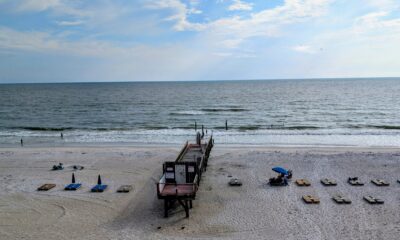City meets with contractors about Tropicana Field
Engineering firms and master developers posed questions to city officials regarding the needed utilities to the assessed value of the Tropicana Field site during the first pre-proposal meeting.
The pre-proposal meeting, held Wednesday at the University of South Florida’s St. Petersburg campus, is part of the due diligence process in selecting a master developer to reimagine the 86-acre site, once home to the Historic Gas Plant District.
St. Petersburg Mayor Ken Welch released a new 33-page RFP in late August to solicit proposals for the redevelopment of the site.
The new RFP language has an emphasis on transforming the site into a destination with affordable and workforce housing, sustainable development, resiliency and intentional equity, while making it a requirement for developers to include a new stadium for the Tampa Bay Rays.

The land available for the redevelopment of the Tropicana Field/Gas Plant District site. Image: City of St. Petersburg.
City officials made presentations about the needs of the community and what’s expected from the RFP respondents.
The discussion was led by City Director of Economic and Workforce Development Brian Caper. The presenting officials included Chief Equity Officer Foundation for a Healthy St. Petersburg Carl Lavender, Community and Neighborhood Affairs Administrator Amy Foster, City Development Administrator James Corbett, City Director of Sustainability and Resiliency Sharon Wright, and City Director of Engineering and Capital Improvements Brejesh Prayman.
Highlights of the Q&A panel and data presented by city officials:
What to know about the site and community needs
- Land at Parcel G (as indicated on the map above) is a city-owned, 2-acre parcel that may or may not be developed. The 17.3-acre shaded area is the dedicated acreage for a new baseball stadium.
- The respondents must work collaboratively with the Tampa Bay Rays regarding the future stadium.
- The vying developers must follow the RFP’s 23 guiding principles.
- The prospective developers must prioritize housing affordability and maximize the number of affordable and workforce units on the site. Developers can make financial contributions to the city’s housing fund and the development of offsite housing. The housing should include mixed-income options serving those earning 20% to 120% of the area median income (AMI). The needed housing is critical as St. Pete must produce 1,000-1,500 new residential units a year to correspond with the population growth in the city; however, the city only has 673 units come online per year, creating a large deficit. Housing rentals in the last year have also jumped by 25%.
- The city aims to be a 100% clean energy metro. Vying developer should address how they will help the city achieve this goal.
- The proposers must honor the history of the Gas Plant neighborhood.
- Booker Creek flooding issues must be addressed.
- The developers must provide the plans for the buildout to the utility and engineering department to allow the city to work with the developers.
- The team will have to secure engineers and architects selected through a CCNA (Cisco Certified Network Associate) process.
- The responding developers must include at least five references in their proposals, including one or more large scale public-private collaboration, mixed-use or urban projects they worked on that encompassed 25 acres or more and/or had a project cost of $100 million.
- The proposers must identify any public funding they plan to utilize, as well as their history of securing state, federal and/or local funding dollars. They must also include a 20-year cash flow analysis.
- The new proposals must be submitted by Nov. 18 at 10 a.m.
Q&A panel
Caper addressed the majority of the questions. The questions and answers have been edited for clarity.
- Question: Jon Gotwald of Osborne Engineering asked if the selected developer would be responsible for the needed utility infrastructure offsite, or if it’s part of the $75 million in TIF funding earmarked for infrastructure improvements from the Intown CRA. Answer: If the system the developer is trying to connect to requires major substantial improvements that are outside of the service the city would provide, then the development team is responsible unless the system improvements were part of a city plan. Any federal or city funds for the site have to comply with the CCNA guidelines.
- David Carlock from Sugar Hill Community Partners, consisting of San Francisco-based developer JMA Ventures and the Machete Group, which is resubmitting a proposal, asked several questions. Question: Can you clarify the criteria for selection? We understand there are 23 principles, should we be looking at this in another way? Answer: The mayor will use those 23 guiding principles and what’s stated in Section 11 of the RFP. Question: Does the $75 million of the city’s funds relate to the stadium portion? Answer: It does relate to the stadium’s specific infrastructure. If it doesn’t utilize the $75 million, then yes, it could be used elsewhere throughout the site. Carlock also asked a question relating to the impact of the Community Benefits Agreement for the site. Caper said the project is considered to be a Tier 3 CBA project. The city didn’t want to prematurely identify anything specific in the redevelopment of the Trop site as it relates to the CBA requirements; however, once the mayor selects a developer, it will then be addressed.
- Question: Brett Sherman, a principal of urban places at Stantec, asked if the Rays looked elsewhere, how one should move forward with the 17.3 acres, and if the city would then issue a separate RFP. Answer: I’m not sure which direction the mayor would like to go at that point, we may elect to have a separate RFP for those 17 acres or fold that into the overall site proposal.
- Question: The unidentified speaker asked if the city would maintain ownership of any of the parcels. Answer: That would ultimately be identified in the development agreement.
- Question: Dick Pierce, a member of the Academy of Senior Professionals at Eckerd College, asked if the city will be receptive to proposals that have leasing or purchasing options for the land as it will affect affordable housing and the possibility of tax exemptions for affordable housing. Answer: The city is open to both options and would work with the developer to identify possible exemptions. Question: Pierce also asked if the assessment could be provided and if the property value would include the existing baseball stadium. Answer: The city is in the process of doing an updated appraisal of the site. It would exclude 17.3 acres and provide a separate appraisal for the optional site. We are looking to publish the appraisal later this fall on the city’s website.
Additional questions can be sent to Caper. A Q&A webpage will be posted on the city’s website. The city will also be providing other supporting documents.
Snapshot of St. Pete’s current economic landscape
The information was presented to help inform and guide prospective developers.
- Introductory info: Roughly 260,778 people call St. Pete home, making the metro the fifth largest city in Florida. The educational attainment of residents is higher than the U.S. average. The household median income is $61,361.
- Real estate: The downtown Class A office space has a vacancy rate of 5.5% and a $33.78 rental rate per square foot. The downtown office space in all classes has a vacancy rate of 4.2% and a $31.15 rental rate per square foot. Citywide retail space has a vacancy rate of 3.9% and a $20.17 rental rate per square foot.
- Employment: Roughly 123,000 people have jobs in the city. The top five industries in the city include health care and social assistance, retail trade, finance and insurance, accommodation and food services and manufacturing.








Peter Kent
September 20, 2022at8:49 pm
I am concerned that the mayor’s new name for the Trop as the “Historic Gas Plant Redevelopment” subliminally captures his vision for the future of St. Petersburg as in the past rather than looking forward to the 21st century. His RFD2 redevelopment vision is subsidizing the Rays MLB and 50% affordable housing rather than a vibrant new center attracting say the financial industry’s move from NYC or work-from-home technology industries.
I could support building 3000 affordable smaller European sized apartments and condos clustered together plus reasonable city-wide rent subsidies if I could be shown a number of US cities where a similar approach has continued to fairly solve an affordable housing issue long-term.
I would offer the Ray’s rent-free use of the existing Tropicana Field plus a city built paid parking garage or encourage them to build a stadium in the Tampa Bay area. But I am not yet convinced that Pinellas County residents get enough intangible “MLB Branding” benefits from the Rays to justify continue to give them an annual $30 million subsidy from the county bed tax [$39.42 subsidy per Rays attendee!] plus ½ of the RFP2 development profits .
RFP2 is based on residents giving away both our land cheaply plus our taxes to special interests without justifying the fairness of their benefits. Rather it should look towards the future and benefit the entire city equally. RFP3?
Peter Kent, St. Petersburg resident and ASPEC Treasurer